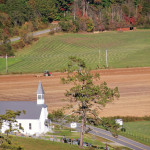Preserving A Farm’s Beauty in North Carolina’s Big Sandy Mush
A flat grassy patch atop the sloped wooded pasture on his western North Carolina farm affords Dave Everett sumptuous views of the Big Sandy Mush Valley and several 4,500-foot-plus peaks beyond. Fooled by Dave’s presence in the pasture in the early afternoon,...

Preserving A Farm’s Beauty in North Carolina’s Big Sandy Mush
A flat grassy patch atop the sloped wooded pasture on his western North Carolina farm affords Dave Everett sumptuous views of the Big Sandy Mush Valley and several 4,500-foot-plus peaks beyond. Fooled by Dave’s presence in the pasture in the early afternoon,...A flat grassy patch atop the sloped wooded pasture on his western North Carolina farm affords Dave Everett sumptuous views of the Big Sandy Mush Valley and several 4,500-foot-plus peaks beyond. Fooled by Dave’s presence in the pasture in the early afternoon, a handful of cows begin bellowing, anticipating a meal.
Dave and his wife, Kim, tend to their farm and their 30-head of cattle with the help of their Massey Ferguson 1540 with 4WD, which allows them to manage the steep inclines of their hilly pastureland with ease.
In addition to farming, the Everetts have helped restore and preserve the fields, woods and streams that spread out below their pastures. “We said that we want this farm to be recognizable to folks who lived here 100 years before us,” Dave says.
In the bucolic Sandy Mush area, such preservation efforts are not as easy as they may sound. The region—actually two valleys with several coves in each—is within 15 miles of the bustling mountain tourist mecca of Asheville. Nearby mountains and valleys are prime targets for vacation and second home developments consisting of 3,500-square-foot “cabins.” Kim and Dave themselves first used the area as a getaway when living near Washington, D.C.
Simply put, the value of the land in the area is worth a lot more for development than it is for farming or open space.
Despite that, owners of nearly 25% of the valley’s land (approximately 7,000 acres) have placed their property in conservation easements. Going forward, the easements require the land be kept in agriculture, forest and/or open space regardless of who owns the property. This is true for the Everetts, who have put their entire 130-acre farm in such an easement, which is held by the Buncombe County Soil and Water Conservation District.
“That one-quarter of the land in this valley is in conservation easement is pretty darned impressive,” says Dave. “There are few things in life that carry your imprint into perpetuity for the enjoyment of future generations. That is hard to put a price tag on.”




